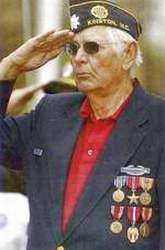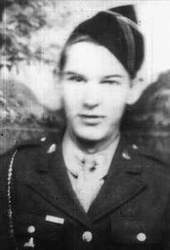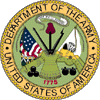Marvin Paul Sizemore was born March 17, 1923 in Concord, North Carolina. When the Japanese bombed Pearl Harbor he was working for Elmore Construction Company on a government project building the Quartermaster Depot in Charlotte, North Carolina.
Marvin entered service on 19 January 1943 after being drafted into the Army. He received basic training at Camp Roberts, California, after which he was assigned to the 96th Infantry Division at Camp Adaire, Oregon. He was sent on maneuvers in eastern Oregon to train in desert-like terrain in preparation for departure to North Africa. After two months of maneuvers the campaign in North Africa ended and he was sent to Camp White, Oregon, then to Camp Callan, California where he received amphibious training. He was then sent to San Luis Obispo, California and on to Camp Stoneman, California for more training. During his time at Camp Stoneman, two ships that were anchored at Port Chicago accidentally exploded and leveled the whole town.
On July 25, 1943 he was sent to San Francisco where he boarded the USS President Polk, a converted cruise ship, and sailed four days to Hawaii. En route the ship picked up a submarine on SONAR and went to full speed to outrun the slower vessel.
Upon arriving in Hawaii his company was assigned to Kailua Beach where they camped on the beach in squad tents that housed eight men. Pearl Harbor was still in disarray; some of the ships that had been bombed during the Japanese attack were still being repaired and the wreckage of the destroyed ships was still visible in the shallow harbor.
He left Pearl Harbor and zigzagged across the Pacific to a small island in the Solomon chain called Eniwetok. The Marines had just taken that island and it was littered with debris on the beach and floating in the water, including the bodies of Japanese soldiers that had died during the battle.
The 96th Infantry was originally supposed to go to a small Island called Yap. However while at Eniwetok their orders were changed and they were sent instead to Leyte, Philippines.
On October 20, 1944 he landed on Leyte where he was involved with his first battle as the 96th Infantry captured Catmon Hill after a fierce battle. They continued to be involved in small skirmishes with the Japanese on a daily basis.
He sailed from Leyte on 25 March 1945 and landed on Okinawa, Japan Easter Sunday, 1 April 1945. They advanced across the island avoiding Machine gun nests and taking out small pockets of resistance. The 96th Infantry advanced so quickly across the island that at one point two US Navy planes coming from the east shot at them by mistake. It was only after they laid out their recognition banners that the planes left.
On 9 April 1945 they advanced on a ridge that was heavily defended by Japanese machine guns, mortars and artillery. On 10 and 11 April 1945 they made assaults on the ridge only to be repelled. On 12 April 1945 they made two assaults on the ridge and once again were repulsed by heavy mortar fire falling at the rate of 2-3 per second. They took heavy casualties at each attempt.
His company was involved in heavy fighting for thirteen days straight with no sleep. They would attack the Japanese during the day and the Japanese would counter attack at night. Finally his company was relieved by the 27th Infantry division. He received the Bronze Star for actions during this battle.
The 96th Infantry received the Presidential Unit Citation for actions on Okinawa. The citation reads “The 96th Infantry Division and attached units distinguished themselves during the period 1 April 1945 to 30 June 1945, by extraordinary heroism and gallantry in action against the enemy in the conquest of Okinawa, Ryukyu Islands, Japan…The division killed a total of 37,763 of the enemy in 73 days of fighting. Its own battle losses totaled 7,294, including 1,504 killed. The brilliant victories achieved by the 96th Division on Okinawa contributed greatly to the defeat of the large enemy garrison. The esprit, heroism and continuing demonstrations of raw courage throughout the battle exemplified the highest traditions of the military service.” The 96th Infantry was one of only four divisions that received the Presidential Unit Citation for actions during World War II. (Note from Walk of Honor, this deserving award was delayed for fifty-six years. Approval was given by the Army Awards Branch on January 22, 2001. The Citation was formally presented on July 27, 2001 at the 96th Infantry division reunion in Omaha, Nebraska.)
In July after Okinawa was taken by the 10th Army, consisting of two Marine divisions and four Army divisions, including the 96th Infantry, Marvin was sent to Guam where he was hospitalized for Post Traumatic Stress Disorder. While in the hospital the war ended after the US dropped atomic bombs on Hiroshima and Nagasaki in August 1945.
He was released from the hospital and was sent to Siapan for reassignment to his unit. He had accumulated enough points to be sent home and on Armistice day, 11 November 1945 he sailed for the United States. As his ship left the harbor, at 11:00 am, all of the ships blew their horns and whistles in celebration of Armistices day.
Marvin was honorably discharged from Fort Bragg, North Carolina on 4 December 1945. During his service he was awarded the Bronze Star, Asiatic Pacific Campaign Medal, American Defense Medal, Philippine Liberation Medal, Victory Medal, Good Conduct Medal, and the Combat Infantry Badge. The 96th Infantry, of which he was a part, received the Presidential Unit Citation and the Philippine Presidential Unit Citation.
Marvin moved back to Charlotte and married Helen Stewart on January 31, 1955. He now lives in Kinston, North Carolina where he is retired and plays golf. Two of his brothers also served in World War II, both in the Navy fighting in the Pacific theater.
Marvin Paul Sizemore passed away on Sunday April 3, 2011.



